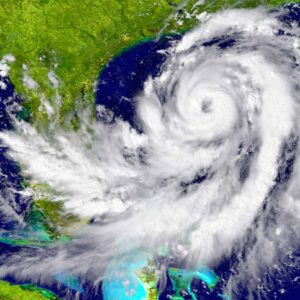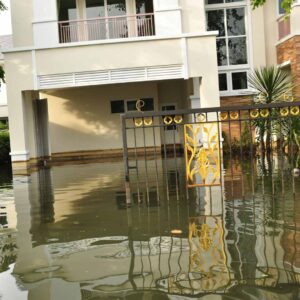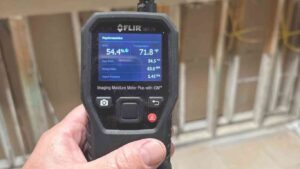The 2024 Hurricane Season has been a busy one for Floridians and South Georgians. With recent back-to-back hurricanes, the west coast of Florida has been especially impacted. Hurricane Helene wreaked havoc in late-September while Hurricane Milton struck a mere 2 weeks later. These storms brought significant storm surge and even high winds to parts of Central and North Central Florida. Hurricane water damage must be treated differently than more routine water damage caused by slab leaks, pipe breaks, ice maker line leaks, etc. Discover why water from hurricanes has to be treated differently and what you should do if you’ve experienced water damage from hurricanes.

Hurricane Water Damage Is Considered Category 3
In the property damage restoration industry, professionals use classification systems to devise the best approach to water cleanup. Depending on the source, water can be “clean,” “grey,” or “black.” The governing body of this water classification standard is the Institute of Inspection, Cleaning, and Restoration Certification (IICRC). These standards are contained in the IICRC S500. Here is a break-down of each category:
- Category 1: Clean Water. This is water from a sanitary source such as a water supply line. Clean water is usually not a threat to human health.
- Category 2: Grey Water. This water contains more contamination than clean water and usually comes from dishwasher overflows, washing machines, etc. It requires more caution because it contains microorganisms and other contaminants.
- Category 3: Black Water. This water is highly contaminated and will cause significant negative health effects to humans. This water is from sources like sewage backups, hurricane storm surge, or flooding from ponds, rivers, or lakes.
Although many water damages can fall into any of the 3 categories with some variability in terms of time elapsed and other variables, hurricane water damage is automatically a category 3 water loss.
What Makes Hurricane Water Damage Different?
The ocean is loaded with a cornucopia of macro and microorganisms. It’s also replete with pollutants. Storm surge from hurricanes also picks up more pollutants and bacteria as it traverses over land. These contaminants and pollutants include bacteria from backed-up sewage lines, sand, mud, debris, oil, gasoline, heavy metals, chemicals, and more.
All of these contaminants then enter your home or business. Most materials that come into contact with this water–especially porous materials are now completely contaminated and must be disposed of. This includes furniture, drywall, clothing, appliances, etc. Some non-porous materials may be salvaged but 90% of the time, all affected materials must be disposed of. If the water level in your property is 4 feet, for example, the walls should be flood-cut an additional 2 feet beyond the water level. This includes the removal of drywall and insulation.

The remaining studs, baseplates, and concrete must be dried in place and scrubbed clean, HEPA vacuumed, and treated with anti-microbial agents. Following these best practices will ensure your property properly dries out to prevent future mold growth and protect occupants once the property is restored.
What Are the Potential Health Risks of Untreated Category 3 Water Damage?
Improperly treated hurricane water damage will not only lead to future mold growth but also lead to respiratory issues, skin irritation, long-term illness, sickness from viruses, etc. If you’re a business owner, an inadequately treated office space may open you up to future liability from employees and customers. Category 3 water damage is something you want to take very seriously and only have qualified professionals handle.
How an Indoor Air Quality Assessor Can Help
Indoor air quality (IAQ) professionals can provide third-party inspection and testing services. IAQ assessors use specialized tools to identify airborne contaminants, such as mold spores, VOCs, and bacteria, that are not always visible to the naked eye. They can come out to your property to take various samples and ensure that your contractor has done an adequate job in mitigating the water damage. They act as a “referee” in this situation.

After their inspection, assessors can create a protocol/plan to address any outstanding issues regarding proper water mitigation. This will ensure your home or office is restored to health–giving you peace of mind.
What Should I Do After Experiencing Hurricane Water Damage?
After you’ve returned to your property following a hurricane, hire a local, professional air quality assessor to help you come up with a water damage recovery plan. This professional can work hand-in-hand with a property damage restoration contractor to ensure your dry-out is properly handled from day 1. Your IAQ assessor also serves as an objective, third-party resource, free of any conflicts of interest–allowing you to hold your restoration contractor accountable.
Ensure that you document as much as you can when you return to your property. Take plenty of pictures, take notes, etc. Then, call your insurance company to file a claim. Once you’ve filed a claim, the IAQ professional and/or your restoration contractor can help you with the claims management process as the project progresses. Your professional contractors will also be documenting everything as they go.
Have You Experienced Water Damage? Give Flo-Air a Call for Third-Party Testing in Florida and South Georgia!
At Flo-Air Services, we provide professional indoor air quality (IAQ) and mold testing services in Florida and South Georgia. Our team is headquartered in Jacksonville, Florida, and has years of experience in the industrial hygiene and property damage restoration industry. If you need someone in your corner following a devastating loss from a hurricane, give our team a call today!
